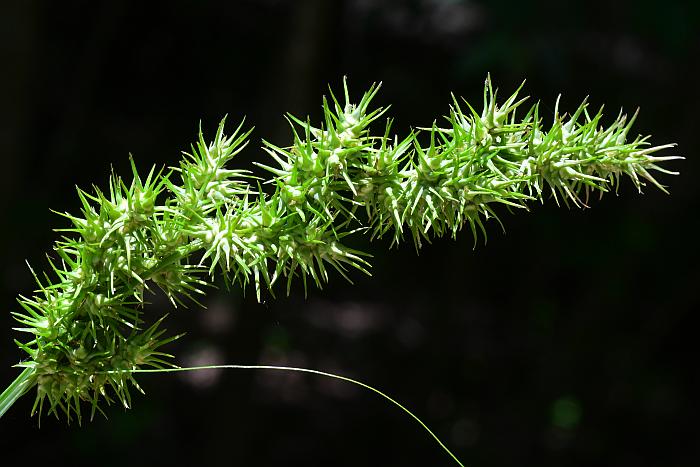Carex crus-corvi Shuttlew. ex Kuntze
Raven's Foot Sedge

Native
CC = 6
CW = -5
MOC = 41
© SRTurner
Carex crus-corvi Shuttlew. ex KuntzeRaven's Foot Sedge | |
 |
Native CC = 6 CW = -5 MOC = 41 |
© SRTurner |
|
Family - Cyperaceae Habit - Monoecious sedge, with short or poorly developed rhizomes, forming tufts or clumps. Stems - Flowering stems 30-100 cm long, sharply trigonous and often narrowly winged, soft and easily crushed, often flattening upon drying. Leaves - Leaf blades 4-70 cm long, 5-10 mm wide, grayish green to green, sometimes glaucous. Leaf sheaths truncate to shallowly concave at the tip, the dorsal side white with green veins or mottled green and white, also with scattered, short, dark green or brown cross-lines (these actually darkened cross-walls of the cells, clearly visible with magnification), the ventral side thin, papery, white to tan with scattered red dots, only rarely cross-wrinkled, often breaking up at maturity, the ligule wider than long and U-shaped.
Inflorescences - Compound, with relatively elongate basal branches, with numerous spikes.
Perigynia - Pistillate scales 3-4 mm long, white to tan with a green or straw-colored midrib. Perigynia 6-8 mm long, 1.0-2.2 mm wide, narrowly triangular in outline, green, the tip long-tapered to a beak 2-3 times as long as the main body, the base truncate, abruptly swollen with spongy tissue into a yellow to brown, disklike structure, the ventral surface nerveless or more commonly with 5-7 faint nerves, the dorsal surface with 10-12 strong nerves. Fruits 1.8-2.5 mm long.
Flowering - May - July. Habitat - Swamps, sloughs, bottomland forests and prairies, streambanks, ditches; sometimes emergent aquatics. Origin - Native to the U.S. Lookalikes - C. conjuncta. Other info. - This sedge is found in scattered locations across much of Missouri, particularly in the eastern and western counties, and along the big rivers. Its main range is within the U.S. Midwest. This sedge is one of the more easily species of Carex. The inflorescences are very large with a distinctly spiky appearance due to the long beaks on the perigynia. Close examination of the perigynia will also show a well-defined disklike structure at the base, which contains amorphous spongy material. The achene is thus considerably shorter than the perigynium. Photographs taken at Otter Slough Conservation Area, Stoddard County, MO, 5-29-2020 (SRTurner). |